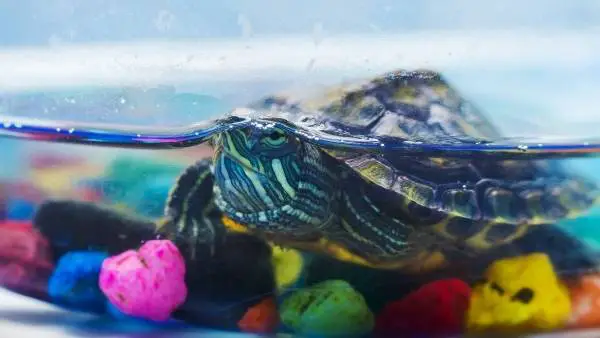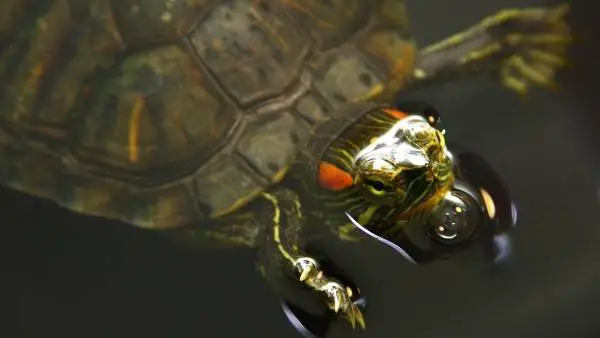Yes, unfortunately, pet turtles can drown, but it does not commonly happen. A typical reason for your pet turtle drowning could be if they get stuck underwater and cannot reach the surface in time by becoming entangled with a plant or other aquarium decoration. Additionally, they can also drown by choking on something from within your tank.

How Do Turtles Drown?
If you are an owner of an aquatic turtle, then you will know that they cannot live entirely underwater. Unlike fish, turtles are reptiles that breathe air. They can, however, hold their breath for an incredibly long time, sometimes for several hours or even more depending on the level of activity they are partaking in.
Typically, when turtles are resting or sleeping, they will hold their breath for around 7 hours, and sometimes longer if they are hibernating. They do, however, need to come to the surface on occasion to intake the air.
The most common way in which turtles can drown is if they are stopped from reaching the surface of the water and therefore cannot breathe in oxygen which will result in them drowning.
When a turtle gets stuck or inadvertently trapped by an object underwater, it will likely panic and become agitated, which will cause them to use up more of their stored oxygen.
Additionally, turtles eat pretty much anything that can fit in their mouths, which is why they have been known to eat fish and choke on their bones which can result in drowning.
How Do You Know If Your Turtle Is Dead?
If you notice that your turtle is not active, and hasn't been for a while, it could be dead, or just having a long sleep. Make sure that if you suspect your turtle to be dead that you do not turn it upside down as it may have some stored air still available in its lungs and by turning it over you will be depriving it of that.
There are several ways of knowing that your turtle has unfortunately died, let's dive in.
1. Floating on The Surface
After a turtle dies, gases will build up within their bodies, which results in them becoming buoyant and able to float. Some turtles decide to float around when alive too, so keep that in mind!
2. Completely Unresponsive
If your pet turtle is completely unresponsive you must set it down on a flat surface and push down on its legs. Doing this will help push water out of its lungs, or disturb and annoy your turtle, so, if you get a bad response from it, at least you know it is still alive!
If this does not work and your turtle is still unresponsive, put on a glove and apply light pressure to the tail and cloacal area, if there is still no response, unfortunately, your turtle has drowned or possibly died from another cause.
You should always check for breathing and movements from your turtle, even if they are tiny breaths, your turtle is still alive and will require medical attention immediately.
3. Horrible Smell/Odor
The odor of a dead turtle will certainly alert you to the problem. Once dead, they begin to decompose, and the microorganisms that will feed on the tissue will produce some ghastly smells. If you notice the smell, check your turtle immediately as it could be decomposing.
How Long Does It Take for a Turtle to Drown?
It is all totally dependent on the situation and indeed, the type of turtle you own as some turtles may spend minutes, hours, and even weeks underwater. However, typically, your pet turtle will come up to the surface for air every 4-5 minutes or so. Some studies have shown that pet turtles can spend approximately 35 minutes underwater before needing to resurface.

Turtles are cold-blooded reptiles, which means they rely on external heat sources to keep their body temperature up. Turtles' metabolisms are heavily affected by warmth too.
When turtles become too cold due to water temperature, their metabolisms will slow down and vice versa when they become warmer. This might seem good, but a faster metabolism will require more oxygen meaning that they need to resurface more.
Another factor that plays a role in the length of time turtles can survive underwater is hibernation. During the cold, winter months, when food is not readily available, many species of turtles will bury their bodies at the bottom of a lake or river where the temperatures are cooler.
This is because the cooler temperatures will decrease their metabolism a lot so they will not need as much oxygen and nutrition to survive and breathe underwater. Your pet turtle will not need to do this as your aquarium will not experience cold winter months!
How Long Does a Turtle Have After Drowning?
Strangely enough, turtles can actually come back to life after drowning, whether that be a few hours after or even a day after. This is due to their body system shutting down temporarily after drowning. If you feel you have discovered your pet turtle within hours or up to a day after you suspect it has drowned or you last saw it alive, then there may still be hope for revival.
Can You Revive a Drowned Turtle?
You certainly can revive a drowned turtle as it may just be unconscious or struggling to breathe due to a lack of oxygen. Fortunately, turtles can survive without oxygen for hours or several hours in some instances, all depending on their metabolism and the water temperature which is why you should always attempt to revive your turtle if you suspect it has drowned.

Something to bear in mind is that you should never lay a turtle on its back during revival as it may remove the last bit of oxygen in its lungs. You must remain calm, try your best, and bring it straight to your vet as soon as you can.
Here are some methods of turtle revival that you need to know:
- Remove your turtle from the tank and hold it vertically with the head of the turtle pointing downwards.
- Extend the neck by grabbing your turtle behind the ears, on the base of the head, and pull the neck out.
- With your other hand, hold the tail and pull it up whilst pointing the head downwards. If water starts to drip from its mouth, it is working.
- Once the water has stopped dripping, lie your turtle down on a flat surface with its shell facing up.
- Pull its front legs towards you, and then push them backward, which will help try and pump up the lungs.
- Keep repeating the pumping action for several minutes, this will help to remove the excess water from your turtle's lungs. Hopefully, this can help revive your turtle, but you should always take it to your vet, despite having potentially brought it back to life.
Answers to Popular Questions
Let's check out some of the most frequently asked questions regarding this topic.
Can Baby Turtles Drown?
Yes, and unfortunately, baby turtles are more susceptible to drowning than adult ones for a few reasons. For starters, they are much smaller and have a fair smaller lung capacity, meaning they cannot stay under for as long, and they will get tired easier.
Another reason is that they are weaker swimmers and may not be able to find the energy to reach the surface if they are residing in a deep tank.
Can Turtles Drown While Sleeping?
The likelihood of your turtle drowning whilst asleep is incredibly slim, but it is still possible. The most possible scenario is perhaps your turtle getting stuck and drowning after waking up and trying to resurface.
Can Turtles Drown in Too Much Water?
Turtles will not drown in too much water, but they can if they swim too deep in the water and do not have the energy to resurface. Most pet turtles will not be in an aquarium that is deep enough to cause them any real issues in getting to the surface reasonably quickly.
